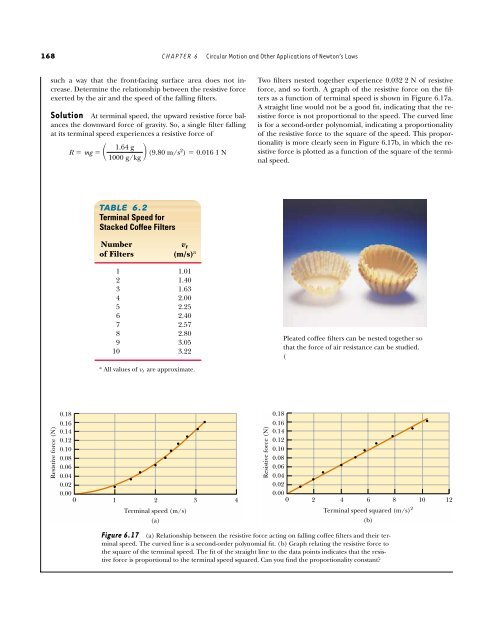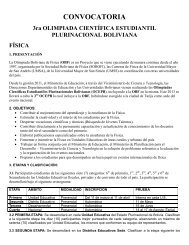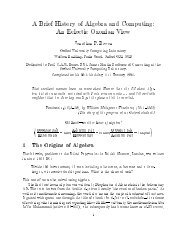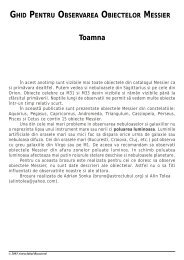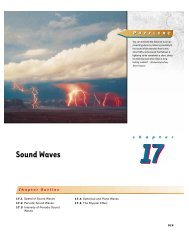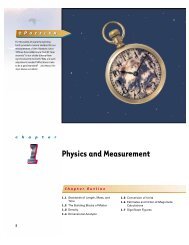Circular Motion and Other Applications of Newton's Laws
Circular Motion and Other Applications of Newton's Laws
Circular Motion and Other Applications of Newton's Laws
Create successful ePaper yourself
Turn your PDF publications into a flip-book with our unique Google optimized e-Paper software.
168 CHAPTER 6 <strong>Circular</strong> <strong>Motion</strong> <strong>and</strong> <strong>Other</strong> <strong>Applications</strong> <strong>of</strong> Newton’s <strong>Laws</strong><br />
such a way that the front-facing surface area does not increase.<br />
Determine the relationship between the resistive force<br />
exerted by the air <strong>and</strong> the speed <strong>of</strong> the falling filters.<br />
Solution At terminal speed, the upward resistive force balances<br />
the downward force <strong>of</strong> gravity. So, a single filter falling<br />
at its terminal speed experiences a resistive force <strong>of</strong><br />
1.64 g<br />
R � mg �� 1000 g/kg� (9.80 m/s2 ) � 0.016 1 N<br />
Resistive force (N)<br />
TABLE 6.2<br />
Terminal Speed for<br />
Stacked C<strong>of</strong>fee Filters<br />
Number v t<br />
<strong>of</strong> Filters (m/s) a<br />
1 1.01<br />
2 1.40<br />
3 1.63<br />
4 2.00<br />
5 2.25<br />
6 2.40<br />
7 2.57<br />
8 2.80<br />
9 3.05<br />
10 3.22<br />
a All values <strong>of</strong> vt are approximate.<br />
0.18<br />
0.16<br />
0.14<br />
0.12<br />
0.10<br />
0.08<br />
0.06<br />
0.04<br />
0.02<br />
0.00<br />
0 1 2 3<br />
4<br />
Terminal speed (m/s)<br />
(a)<br />
Two filters nested together experience 0.032 2 N <strong>of</strong> resistive<br />
force, <strong>and</strong> so forth. A graph <strong>of</strong> the resistive force on the filters<br />
as a function <strong>of</strong> terminal speed is shown in Figure 6.17a.<br />
A straight line would not be a good fit, indicating that the resistive<br />
force is not proportional to the speed. The curved line<br />
is for a second-order polynomial, indicating a proportionality<br />
<strong>of</strong> the resistive force to the square <strong>of</strong> the speed. This proportionality<br />
is more clearly seen in Figure 6.17b, in which the resistive<br />
force is plotted as a function <strong>of</strong> the square <strong>of</strong> the terminal<br />
speed.<br />
0 2<br />
6 12<br />
Terminal speed squared (m/s) 2<br />
0.18<br />
0.16<br />
0.14<br />
0.12<br />
0.10<br />
0.08<br />
0.06<br />
0.04<br />
0.02<br />
0.00<br />
4<br />
8 10<br />
Figure 6.17 (a) Relationship between the resistive force acting on falling c<strong>of</strong>fee filters <strong>and</strong> their terminal<br />
speed. The curved line is a second-order polynomial fit. (b) Graph relating the resistive force to<br />
the square <strong>of</strong> the terminal speed. The fit <strong>of</strong> the straight line to the data points indicates that the resistive<br />
force is proportional to the terminal speed squared. Can you find the proportionality constant?<br />
Resistive force (N)<br />
Pleated c<strong>of</strong>fee filters can be nested together so<br />
that the force <strong>of</strong> air resistance can be studied.<br />
(<br />
(b)


